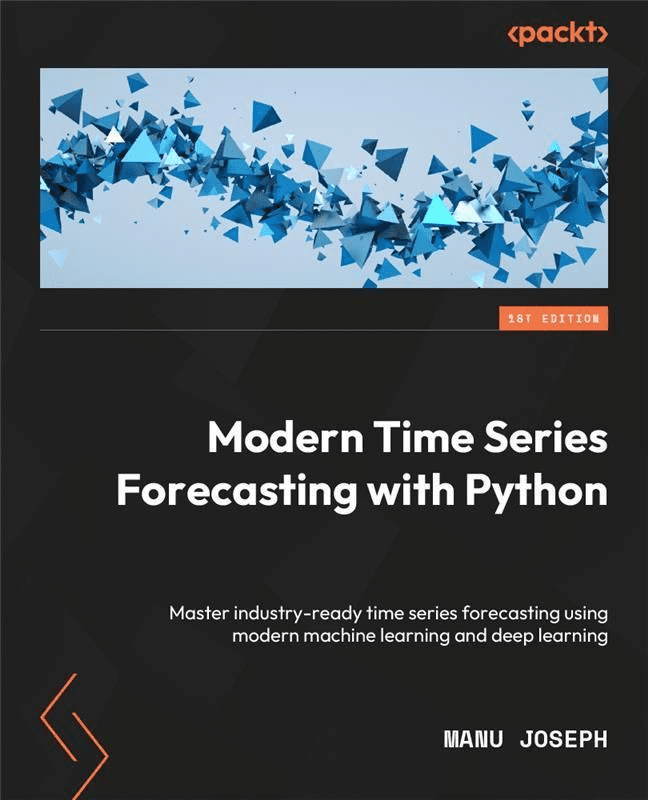Manu Joseph is the author of Modern Time Series Forecasting with Python; we got the chance to sit down and find out more about his experience of writing with Packt.
Q: What are your specialist tech areas?
Manu: Machine Learning, Deep Learning, Time Series Forecasting.
Q: How did you become an author for Packt? Tell us about your journey. What was your motivation for writing this book?
Manu: It was a bit serendipitous. I had been toying with the idea of writing a book for some time. And one day, Ravit Jain (who was part of Packt at the time) reached out to me about exploring opportunities about writing a book with Packt. One thing led to another, and I connected with Dhruv Kataria and started talking about writing a book for time series forecasting. Although there were many books that covered this at the time, there was none that covered the modern aspects of time series forecasting. The majority of the books were only covering techniques which were invented 60-70 years ago. And from my experience working in the industry, I know that there are a lot of new techniques which are much more effective. And that’s how the idea of the book came about.
Q: What kind of research did you do, and how long did you spend researching before beginning the book?
Manu: Since I had been working with timeseries forecasting as part of my day job, I didn’t have to research a lot on the topics. It took little less than a week to put together the outline of the book. More than researching the subject, I had to spend preparing the practical section with relevant code notebooks. The actual research was done along with writing the book. I would spend a week researching and preparing the necessary code for a chapter and then take a week to write the chapter.
Q: Did you face any challenges during the writing process? How did you overcome them?
Manu: Well, there were many challenges. But the biggest one was when I got saturated with the book. I was spending all my free time on the book so that I wasn’t able to devote any time to other interests. Eventually, I had to take a break from writing to rejuvenate and get back to writing again.
Q: What’s your take on the technologies discussed in the book? Where do you see these technologies heading in the future?
Manu: Machine Learning and Deep Learning are the new frontiers in Timeseries forecasting. With the exponential increase in collected data, scalable modelling paradigms like global modelling is going to have a huge upper hand in both performance and speed. The industrial applications of timeseries forecasting have already started adopting this new paradigm and I see that adoption accelerating in the coming years.
Q: Why should readers choose this book over others already on the market? How would you differentiate your book from its competition?
Manu: While most books in the market considers classical forecasting models like ARIMA as the end, this book starts from that point and explores how we can go beyond those time-tested models. The book considers the older techniques as strong baselines that the modern approaches need to beat and show how we can get convincing performance using modern machine and deep learning models. In addition to that, the book also covers practical aspects like evaluation of forecasts and multi-step forecasting, which get little attention in other books but are of paramount importance in industrial applications.
Q: What are the key takeaways you want readers to come away with from the book?
Manu: There is a whole world beyond traditional timeseries forecasting techniques and I hope the book opens the readers eyes and equip them with enough skills to start exploring these frontiers and build much stronger and robust timeseries forecasting systems in the real-world.
Q. What advice would you give to readers learning tech? Do you have any top tips?
Manu: I have three words: Curiosity, Reading, Practice. Curiosity to keep learning and Reading new technologies to help you stay up to date in an ever-changing technological landscape. And putting the new skills you learn by Reading and Curiosity into Practice solidifies that learning.
Q. Do you have a blog that readers can follow?
Manu: Yes. https://deep-and-shallow.com/
Q: Can you share any blogs, websites and forums to help readers gain a holistic view of the tech they are learning?hat are the key takeaways you want readers to come away with from the book?
Manu: Nothing concrete. I usually use Google as the gateway to all the amazing resources in the internet. Kaggle Forums are another great resource to learn from.
Q. How would you describe your author’s journey with Packt? Would you recommend Packt to aspiring authors?
Manu: My authoring journey with Packt has been a pleasant one. The editors and project managers involved were friendly and accommodating. And they managed to apply just the right amount of pressure to keep me motivated through the journey, but not burnout as well.
Q. What are your favorite tech journals? How do you keep yourself up to date on tech?
Manu: It’s very difficult to keep yourself up to date on the AI/ML field. You have to make a conscious choice on which are the sub-fields you have to try and keep up to date and use the power of the community to help you select a few papers that you can read.
I use these tools to help me do that :
1. Paperswithcode
2. Twitter
3. papers.labml.ai/papers/weekly
4. A few newsletters
Q. How did you organize, plan, and prioritize your work and write the book?
Manu: Well, once I had put down the whole outline, I fleshed it out a bit and decided the broad sub-topics I would be covering in each chapter. Then it was all about writing those chapters, one by one. I used to use early mornings and some part of weekends to actually write the book.
Q. What is that one writing tip that you found most crucial and would like to share with aspiring authors?
Manu: Writing a book is a lot different than a blog. In a blog you decide how you want the flow, however the book has to follow a specific pattern, so it will be good if the author has the whole book flow planned right at the beginning. And make offline copy of everything you write/create.
Q. Would you like to share your social handles? If so, please share.
Manu: GitHub: manujosephv, LinkedIn: Manu Joseph, Twitter : manujosephv
You can find Manu’s book on Amazon by following this link: Please click here









